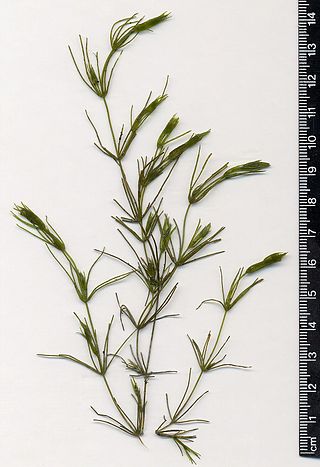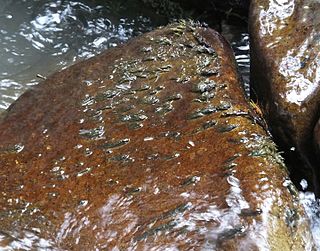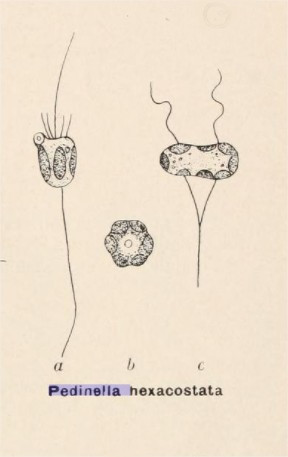
Characeae is a family of freshwater green algae in the order Charales, commonly known as stoneworts. They are also known as brittleworts or skunkweed, from the fragility of their lime-encrusted stems, and from the foul odor these produce when stepped on.

Felix Eugen Fritsch FRS was a British biologist.

Lemanea is a genus of freshwater red algae, in the order Batrachospermales. Both species are considered to be widespread in the northern hemisphere. Although placed in the Rhodophyta it in fact is green in colour.
Thorea is a genus of freshwater algae in the Phylum Rhodophyta. Thorea is a small alga with filaments up to 200 cm long, dark green in colour and not red as are marine Rhodophyta. The filaments have only as few secondary branches.

Chlamydomonadaceae is a family of algae within the order Chlamydomonadales.
Coelastropsis is a genus of green algae in the family Scenedesmaceae, containing the single species Coelastropsis costata. It is found in freshwater lakes and bogs, usually associated with mosses and filamentous algae. It has been recorded in Europe, Cuba and possibly New Zealand.
Dictyochloris is a genus of green algae in the class Chlorophyceae. It is the sole genus of the family Dictyochloridaceae. It is commonly found in terrestrial and subaerial habitats.

Draparnaldia is a genus of freshwater green algae in the family Chaetophoraceae. Draparnaldia are uniseriate; each filament is composed of a chain of cells arranged in one row. Chloroplasts appear as a band within the center of each cell. The length of the main axis cells are generally the same, regardless of whether or not they bear branches. These side branches are divided extensively into terminal hairs. The entire plant is enveloped in loose, slippery mucilage. Draparnaldia is a cosmopolitan genus with wide distribution and it is usually found in cold aerated waters. They are either attached to sand or grow epiphytically on other aquatic plants. Draparnaldia can be seen growing in clear streams trailing on stones and boulders. Herman S. Forest of The Southern Appalachian Botanical Club has stated that while not common, it is present frequently enough to be recorded in almost all local flora lists of green algae that have been compiled. A multitude of species are present in Lake Baikal, Siberia and have been described by Meyer and Jasnitzky. A species of the genus had been placed and described in the Linnean Herbarium as Conferva mutabilis Roth in 1797. Nowadays Conferva is no longer used and the species is described as Draparnaldia mutabilis (Roth) Bory. Bory is added in honour of the researcher of the same name, based on whose description the genus was separated from similar appearing forms. Bory is accredited with the establishment of the genus.
Pseudoschroederia is a genus of green algae in the family Characiaceae. It is planktonic in freshwater habitats, and probably has a cosmopolitan distribution. The genus Pseudoschroederia was circumscribed by Eberhard Hegewald and Eberhard Schnepf in 1986. The genus was distinguished from the similar Schroederia by being heteropolar and differing cell structure. However, some authors do not consider the genera to be separate.
Pseudoscourfieldia is a genus of green algae in the family Pycnococcaceae.

Trentepohlia is a genus of filamentous chlorophyte green algae in the family Trentepohliaceae, living free on terrestrial supports such as tree trunks and wet rocks or symbiotically in lichens. The filaments of Trentepohlia have a strong orange colour caused by the presence of large quantities of carotenoid pigments which mask the green of the chlorophyll.
Treubaria is a genus of green algae, the sole genus in the family Treubariaceae.
Korshikoviella is a genus of green algae in the family Characiaceae.
Komma caudata is a cryptomonad, and the only described species in the genus Komma, although four or five more species may exist. Its cells are 4.5–5.5 μm wide by 7–10 μm long and bear two unequal flagella.

Pedinella is a genus of small, unicellular planktonic or attached, flagellated heterokonts first described in 1888 by A. V. Vysotskij. The genus is monospecific, and the single species is Pedinella hexacostata Vysotskij. Pedinella has an inverted bell or apple shape with a stalk arising from the posterior end, and has a single, long, ribbon-like, apical flagellum and, a second apical flagellum that is reduced to its basal body. The cells are radially symmetrical, with a large central nucleus, surrounded equatorially by a number of chloroplasts that cause the body to bulge out where the plastids are pushed up against the plasma membrane. The organism is found in freshwater and brackish freshwater habitats. Pedinella is a mixotroph and functions through either photosynthesis or by ingesting organic substances from its environment.
Porphyridiophyceae is a class of red algae.

Trentepohlia aurea is a species of filamentous terrestrial green alga with a worldwide distribution. It grows on rocks, old walls and the trunks and branches of trees such as oaks, elms, and the Monterey cypress. The orange coloration results from carotenoid pigments in the algal cells. It is probably the most widespread and abundant species of Trentepohlia in the Britain and Ireland.
Sirogonium is a genus of filamentous charophyte green algae of the order Zygnematales. It is found in freshwater areas on all continents but Antarctica. Spirogyra measures approximately 32–115 μm in width. Each cell contains 2–10 chloroplasts in a ribbon, in contrast to the closely related genus Spirogyra, which has chloroplasts in a coil. Molecular phylogenetic studies have placed Sirogonium inside a clade consisting of Spirogyra species; in other words, Spirogyra is paraphyletic with respect to Sirogonium.

Trentepohlia jolithus is an alga species in the genus Trentepohlia. It has been reported in subaerial habitats from Spain.
Geminella minor is a species of filamentous freshwater green alga in the family Chlorellaceae. The species probably has a cosmopolitan distribution. The type specimen came from Switzerland and the species has been reported in the British Isles and elsewhere in the northern hemisphere, including Japan, Ukraine and North America. It occurs in freshwater aquatic habitats.









